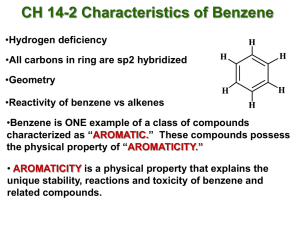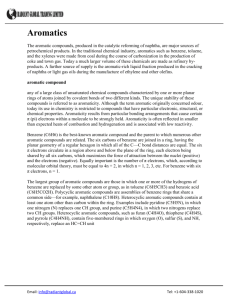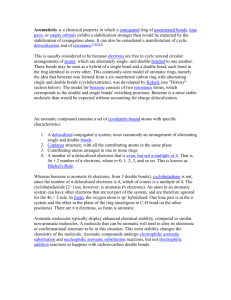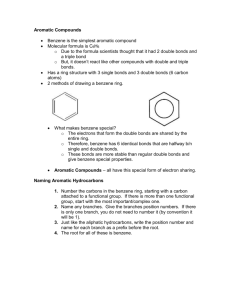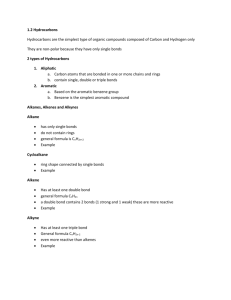Chapter 15 Benzene and Aromaticity Ishaq A.H. Takruri
advertisement
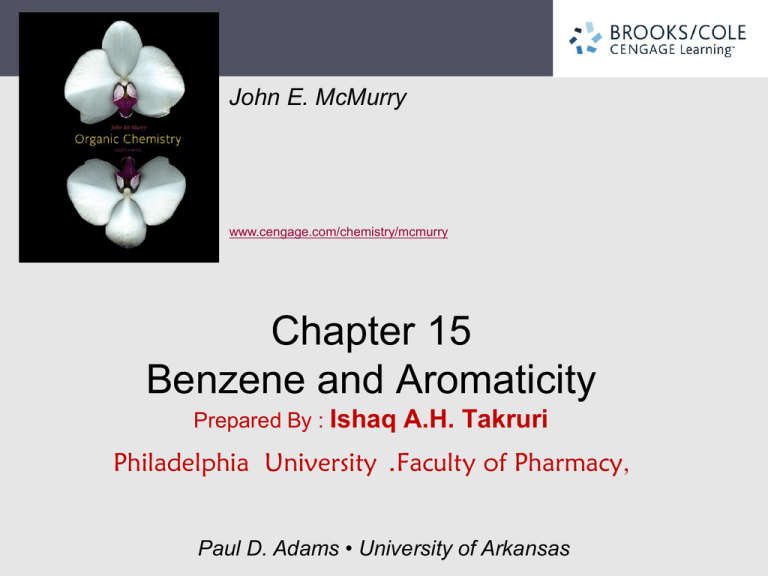
John E. McMurry www.cengage.com/chemistry/mcmurry Chapter 15 Benzene and Aromaticity Prepared By : Ishaq A.H. Takruri Philadelphia University .Faculty of Pharmacy, Paul D. Adams • University of Arkansas Aromatic Compounds Aromatic was used to described some fragrant compounds in early 19th century Not correct: later they are grouped by chemical behavior (unsaturated compounds that undergo substitution rather than addition) Current: distinguished from aliphatic compounds by electronic configuration Why this Chapter? Reactivity of substituted aromatic compounds is tied to their structure Aromatic compounds provide a sensitive probe for studying relationship between structure and reactivity 15.1 Sources and Names of Aromatic Hydrocarbons From high temperature distillation of coal tar Heating petroleum at high temperature and pressure over a catalyst Naming Aromatic Compounds Many common names (toluene = methylbenzene; aniline = aminobenzene) Monosubstituted benzenes systematic names as hydrocarbons with –benzene C6H5Br = bromobenzene C6H5NO2 = nitrobenzene, and C6H5CH2CH2CH3 is propylbenzene The Phenyl Group When a benzene ring is a substituent, the term phenyl is used (for C6H5 ?) You may also see “Ph” or “f” in place of “C6H5” “Benzyl” refers to “C6H5CH2 ?” Disubstituted Benzenes Relative positions on a benzene ring ortho- (o) on adjacent carbons (1,2) meta- (m) separated by one carbon (1,3) para- (p) separated by two carbons (1,4) Describes reaction patterns (“occurs at the para position”) Naming Benzenes with More Than Two Substituents Choose numbers to get lowest possible values List substituents alphabetically with hyphenated numbers Common names, such as “toluene” can serve as root name (as in TNT) 15.2 Structure and Stability of Benzene Benzene reacts slowly with Br2 to give bromobenzene (where Br replaces H) This is substitution rather than the rapid addition reaction common to compounds with C=C, suggesting that, in benzene, there is a higher barrier Heats of Hydrogenation as Indicators of Stability The addition of H2 to C=C normally gives off about 118 kJ/mol – 3 double bonds would give off 354kJ/mol Two conjugated double bonds in cyclohexadiene add 2 H2 to give off 230 kJ/mol Benzene has 3 unsaturation sites but gives off only 206 kJ/mol on reacting with 3 H2 molecules Therefore it has about 150 kJ more “stability” than an isolated set of three double bonds Benzene’s Unusual Structure All its C-C bonds are the same length: 139 pm — between single (154 pm) and double (134 pm) bonds Electron density in all six C-C bonds is identical Structure is planar, hexagonal C–C–C bond angles 120° Each C is sp2 and has a p orbital perpendicular to the plane of the six-membered ring Drawing Benzene and Its Derivatives The two benzene resonance forms can be represented by a single structure with a circle in the center to indicate the equivalence of the carbon–carbon bonds This does not indicate the number of electrons in the ring but reminds us of the delocalized structure We shall use one of the resonance structures to represent benzene for ease in keeping track of bonding changes in reactions Molecular Orbital Description of Benzene The 6 p-orbitals combine to give Three bonding orbitals with 6 electrons, Three antibonding with no electrons Orbitals with the same energy are degenerate 15.3 Aromaticity and the Hückel 4n+2 Rule Unusually stable - heat of hydrogenation 150 kJ/mol less negative than a hypothetical cyclic triene Planar hexagon: bond angles are 120°, carbon–carbon bond lengths 139 pm Undergoes substitution rather than electrophilic addition Resonance hybrid with structure between two line-bond structures Aromaticity and the 4n + 2 Rule Hückel’s rule, based on calculations – a planar cyclic molecule with alternating double and single bonds has aromatic stability if it has 4n+ 2 electrons (n is 0,1,2,3,4) For n=1: 4n+2 = 6; benzene is stable and the electrons are delocalized Compounds with 4n Electrons Are Not Aromatic (May be Antiaromatic) Planar, cyclic molecules with 4 n electrons are much less stable than expected (antiaromatic) They will distort out of plane and behave like ordinary alkenes 4- and 8-electron compounds are not delocalized (single and double bonds) Cyclobutadiene is so unstable that it dimerizes by a self-Diels-Alder reaction at low temperature Cyclooctatetraene has four double bonds, reacting with Br2, KMnO4, and HCl as if it were four alkenes 15.4 Aromatic Ions The 4n + 2 rule applies to ions as well as neutral species Both the cyclopentadienyl anion and the cycloheptatrienyl cation are aromatic The key feature of both is that they contain 6 electrons in a ring of continuous p orbitals Aromaticity of the Cyclopentadienyl Anion 1,3-Cyclopentadiene contains conjugated double bonds joined by a CH2 that blocks delocalization Removal of H+ at the CH2 produces a cyclic 6 electron system, which is stable Removal of H- or H• generate nonaromatic 4 and 5 electron systems Relatively acidic (pKa = 16) because the anion is stable Cycloheptatriene Cycloheptatriene has 3 conjugated double bonds joined by a CH2 Removal of “H-” leaves the cation The cation has 6 -electrons and is aromatic 15.5 Aromatic Heterocycles: Pyridine and Pyrrole Heterocyclic compounds contain elements other than carbon in a ring, such as N,S,O,P Aromatic compounds can have elements other than carbon in the ring There are many heterocyclic aromatic compounds and many are very common Cyclic compounds that contain only carbon are called carbocycles (not homocycles) Nomenclature is specialized Pyridine A six-membered heterocycle with a nitrogen atom in its ring electron structure resembles benzene (6 electrons) The nitrogen lone pair electrons are not part of the aromatic system (perpendicular orbital) Pyridine is a relatively weak base compared to normal amines but protonation does not affect aromaticity Pyrrole A five-membered heterocycle with one nitrogen electron system similar to that of cyclopentadienyl anion Four sp2-hybridized carbons with 4 p orbitals perpendicular to the ring and 4 p electrons Nitrogen atom is sp2-hybridized, and lone pair of electrons occupies a p orbital (6 electrons) Since lone pair electrons are in the aromatic ring, protonation destroys aromaticity, making pyrrole a very weak base 15.6 Polycyclic Aromatic Compounds Aromatic compounds can have rings that share a set of carbon atoms (fused rings) Compounds from fused benzene or aromatic heterocycle rings are themselves aromatic Naphthalene Orbitals Three resonance forms and delocalized electrons Ring Currents Aromatic ring oriented perpendicular to a strong magnetic field, delocalized electrons producing a small local magnetic field Opposes applied field in middle of ring but reinforces applied field outside of ring Let’s Work a Problem Cycloheptatrienone is stable, but cyclopentadienone is so reactive that it can’t be isolated. Explain, taking the polarity of the carbonyl group into account? Answer Draw the resonance forms of the molecules in which both carbonyl electrons are on the oxygen. The cycloheptatrienone ring possesses 6 electrons and is aromatic according to Hückel’s rule. When we do this with the cyclopentadienone ring, we see that it contains 4 electrons and thus is antiaromatic and does not obey Hückel’s rule, resulting in its extreme reactivity.

